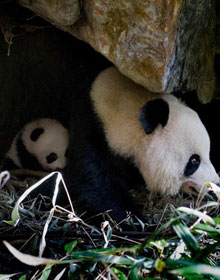
"I think that it’s my unavoidable responsibility as a photographer to vividly present and spread the idea of ecological conservation and love of life."-- Sun Jinqiang, a wildlife photographer from Shannxi province.
|
 Sun Jinqiang |
Q: How did you get into the field of photographing wildlife?
A: I’ve been doing photography for more than 30 years. When I first started photographing wild animals, it was largely a personal hobby. But as I went deeper, I became increasingly aware of the importance of paying attention to ecological environment and taking care of wild animals.
I’m more focused on shooting wild animals, especially those that are rare and endangered in Qinling Mountains. And I mainly shoot them for my series or feature production.
Q: What’s the biggest challenge you’ve ever met?
A: The biggest problems so far lie in the lack of attention paid to the protection of the ecological environment and wildlife within the country. The issue has received a lot of publicity and slogans are shouted many times, but the actual level of protection is far from enough.
Q: What work are you most proud of?
|
 Click here for more photos |
A: The feature photography Golden Monkeys in Qinling Mountains and it won the gold medal at the 8th Chinese Photography Awards. These 20 images were carefully selected from millions of photos that I shot, of monkeys living in the wild in the Qinling Mountains. The shooting took five to six years, and I’d been to the deep of the Qinling Mountains hundreds of times, and had been through all kinds of hardships.
The work Charmingly Na?ve shows a little monkey drinking water by a stream. Before shooting, I’d made multiple observations, and found that after the monkeys fed themselves in the morning, they’d go to drink by a stream. So I hid myself in the woods across the stream in advance and waited for a little monkey to jump off a tree, and I clicked the shutter while it buried its head to drink on a rock by the stream. Maybe the click of the shutter alerted the little creature to my presence, as it vigilantly raised its head and looked in the direction of where I was hiding. The water on its hair around its mouth and jaw trickled down and, combined with its vigilant look, made a lovely picture. So I seized the chance to click the shutter and capture this memorable moment. And this work has become the best one in my golden monkey series and it’s loved by everyone.
Q: Can you recount a story that made a deep impression on you?
Once in the deep jungle of Qinling Mountains, I found that an adult female monkey was holding a cub that had been dead for a long time in her arms. She was holding it even while feeding herself on the tree, drinking by a brook, resting on the ground or napping on a tree. The strong maternal love moved me almost to tears.
Q: What advice can you give to those young photographers?
A: I hope that more and more young photographers will join us. What I want to say is that, when you’re photographing wild animals, you not only have to be hardworking and resilient, you also have to learn something about the physiology and life patterns of wild animals.